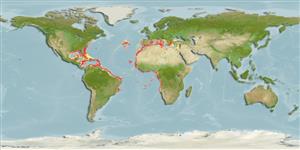Preferred temperature (Ref.
115969): 7.1 - 15.9, mean 12.6 (based on 338 cells).
Phylogenetic diversity index (Ref.
82804): PD
50 = 0.5000 [Uniqueness, from 0.5 = low to 2.0 = high].
Bayesian length-weight: a=0.00162 (0.00101 - 0.00260), b=3.05 (2.91 - 3.19), in cm Total Length, based on LWR estimates for this species & (Sub)family-body (Ref.
93245).
Τροφικό Επίπεδο (Ref.
69278): 3.4 ±0.0 se; based on diet studies.
Ελαστικότητα (Ref.
120179): Μεσαίο(α), ελάχιστος χρόνος για διπλασιασμό πληθυσμού 1,4 - 4,4 έτη (K=0.18; tmax=9).
Fishing Vulnerability (Ref.
59153): Low vulnerability (15 of 100).
